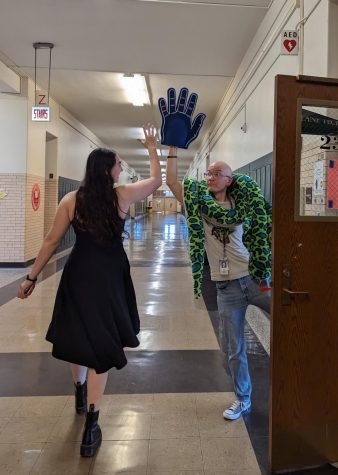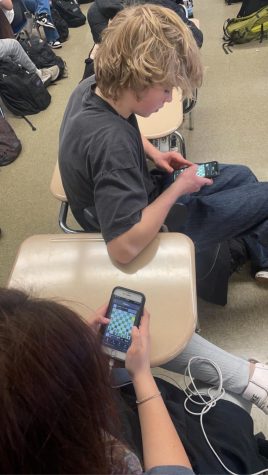From then to now: The decades old quest to decorate Lane
Murals from the Century of Progress Chicago World’s Fair of 1933 and 1934 line the first floor of the building. The murals depict how each state contributed to the creation of the automobile.
June 17, 2019
When alumni return to the school, one of the first questions they ask Ms. Nester, the go-to authority on Lane’s artwork, is when the artwork came to Lane.
“When I tell them they were here the whole time they’re surprised,” said Nester, a World Studies and Human Geography teacher.
Until the mid-90s, most of the artwork around Lane was covered in soot. Then, around twenty years ago, Lane underwent a massive restoration project, according to Nester.
“There was a 10-12 year production of generating grants and getting money and getting all of the artwork clean,” Nester said.
Lane has an expansive collection of historical artwork. According to Nester, there are three collections of historical artwork. The oldest comes from the Progressive Era, with some works dating back to 1909. The artwork came from Lane’s original building at Sedgwick and Division. This collection is located on the north end of the building in the main office hall, in front of the entrance to the library and in room 113.
The second collection is the Works Progress Administration (WPA) collection. The WPA was a Depression-era program designed to create public works projects. According to PBS, the WPA created over 2,500 murals during its lifetime.
Lane has the largest collection of WPA artwork in the nation, Nester said. This collection includes various frescos in the library, lunchroom and auditorium foyer. It also includes the fire curtain in the auditorium and the statue in the memorial garden.
The third collection is from the Century of Progress Chicago World’s Fair of 1933 and 1934. The artwork came from the General Motors exhibit and details the materials each state contributes to the making of the automobile, Nester said.
Avner Tomulet, Div. 052, views the works as historic.
“They’re no doubt impressive, even if they haven’t lived in the most appreciative or suitable environment,” Tomulet said.
Nester also said that she believed that the older artwork around Lane goes unnoticed.
“I’ve noticed damage to multiple pieces in the hallway in front of the cafeteria. I don’t think students realize that they’re there sometimes,” Nester said.
While some of the older artwork may go unnoticed, the newer artwork going up around Lane has not. Ms. Wain, the art teacher who was in charge of putting up the bathroom murals, said that the response has been overwhelmingly positive.
“I had some of my former students come back and be really excited when they saw them get installed,” Wain said.
This will be the fourth year that Wain’s art class has put up murals around Lane. Wain said that she did it because most of the historic artwork around Lane is concentrated on the first floor.
“The halls are a little bare on the second, third and fourth floors,” Wain said.
Wain said that the school was largely supportive of putting up new murals but that they have also taken steps to ensure the murals can be temporary if needed.
“We have painted all of the murals that have been installed on panels; therefore if they wanted to take them down they can just unscrew them from the walls,” Wain said.
The murals themselves are acrylic on hardboard panels and based on famous artworks– everything from Van Gogh’s “Starry Night” to Dali’s “Persistence of Memory.” Wain said that she did this because it exposes students to a wide variety of artwork even if they are not taking an art course.
Tomulet said that he favors the newer installations over Lane’s older artwork.
“I sort of place a little more sentimental value on them since they were made by Lane students,” Tomulet said.
Wain’s class is not the only one installing artwork around Lane.
“Ms. Chisholm’s class did the water fountain outside of the pool a couple of years ago,” Wain said.
The mosaic depicts an underwater scene filled with marine life.
Although Wain works to decorate Lane with murals, she said that the main reason she does them is not to necessarily beautify Lane but because of their impact on students.
“I do it because it’s fun for students to leave a little legacy. They can come back and say ‘I worked on that,’” Wain said.







